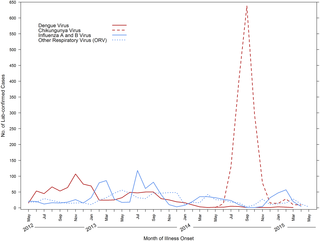PLOS Neglected Tropical Diseases ( IF 3.4 ) Pub Date : 2017-09-13 , DOI: 10.1371/journal.pntd.0005859 Kay M. Tomashek , Olga D. Lorenzi , Doris A. Andújar-Pérez , Brenda C. Torres-Velásquez , Elizabeth A. Hunsperger , Jorge Luis Munoz-Jordan , Janice Perez-Padilla , Aidsa Rivera , Gladys E. Gonzalez-Zeno , Tyler M. Sharp , Renee L. Galloway , Mindy Glass Elrod , Demetrius L. Mathis , M. Steven Oberste , W. Allan Nix , Elizabeth Henderson , Jennifer McQuiston , Joseph Singleton , Cecilia Kato , Carlos García Gubern , William Santiago-Rivera , Jesús Cruz-Correa , Robert Muns-Sosa , Juan D. Ortiz-Rivera , Gerson Jiménez , Ivonne E. Galarza , Kalanthe Horiuchi , Harold S. Margolis , Luisa I. Alvarado

|
Identifying etiologies of acute febrile illnesses (AFI) is challenging due to non-specific presentation and limited availability of diagnostics. Prospective AFI studies provide a methodology to describe the syndrome by age and etiology, findings that can be used to develop case definitions and multiplexed diagnostics to optimize management. We conducted a 3-year prospective AFI study in Puerto Rico. Patients with fever ≤7 days were offered enrollment, and clinical data and specimens were collected at enrollment and upon discharge or follow-up. Blood and oro-nasopharyngeal specimens were tested by RT-PCR and immunodiagnostic methods for infection with dengue viruses (DENV) 1–4, chikungunya virus (CHIKV), influenza A and B viruses (FLU A/B), 12 other respiratory viruses (ORV), enterovirus, Leptospira spp., and Burkholderia pseudomallei. Clinical presentation and laboratory findings of participants infected with DENV were compared to those infected with CHIKV, FLU A/B, and ORV. Clinical predictors of laboratory-positive dengue compared to all other AFI etiologies were determined by age and day post-illness onset (DPO) at presentation. Of 8,996 participants enrolled from May 7, 2012 through May 6, 2015, more than half (54.8%, 4,930) had a pathogen detected. Pathogens most frequently detected were CHIKV (1,635, 18.2%), FLU A/B (1,074, 11.9%), DENV 1–4 (970, 10.8%), and ORV (904, 10.3%). Participants with DENV infection presented later and a higher proportion were hospitalized than those with other diagnoses (46.7% versus 27.3% with ORV, 18.8% with FLU A/B, and 11.2% with CHIKV). Predictors of dengue in participants presenting <3 DPO included leukopenia, thrombocytopenia, headache, eye pain, nausea, and dizziness, while negative predictors were irritability and rhinorrhea. Predictors of dengue in participants presenting 3–5 DPO were leukopenia, thrombocytopenia, facial/neck erythema, nausea, eye pain, signs of poor circulation, and diarrhea; presence of rhinorrhea, cough, and red conjunctiva predicted non-dengue AFI. By enrolling febrile patients at clinical presentation, we identified unbiased predictors of laboratory-positive dengue as compared to other common causes of AFI. These findings can be used to assist in early identification of dengue patients, as well as direct anticipatory guidance and timely initiation of correct clinical management.
中文翻译:

2012-2015年在波多黎各的急性发热性疾病患者中登革热和其他病因的临床和流行病学特征
由于非特异性表现和诊断方法的局限性,识别急性发热性疾病(AFI)的病因具有挑战性。AFI的前瞻性研究提供了一种按年龄和病因来描述综合征的方法,可将其发现用于制定病例定义和进行综合诊断以优化管理。我们在波多黎各进行了为期3年的前瞻性AFI研究。发烧≤7天的患者入组,并在入组时以及出院或随访时收集临床数据和标本。通过RT-PCR和免疫诊断方法对血液和口鼻咽标本进行了测试,以检测登革热病毒1-4(DENV),基孔肯雅病毒(CHIKV),甲型和乙型流感病毒(FLU A / B),其他12种呼吸道病毒( ORV),肠病毒,钩端螺旋体属和假伯克霍尔德氏菌。将感染DENV的参与者的临床表现和实验室检查结果与感染CHIKV,FLU A / B和ORV的参与者进行比较。与其他所有AFI病因相比,实验室阳性登革热的临床预测指标是根据出现时的年龄和病后发病天数(DPO)确定的。从2012年5月7日到2015年5月6日登记的8,996名参与者中,超过一半(54.8%,4,930)的病原体被检测到。最常见的病原体是CHIKV(1,635,18.2%),FLU A / B(1,074,11.9%),DENV 1-4(970,10.8%)和ORV(904,10.3%)。与其他诊断结果相比,DENV感染患者的住院时间较晚,且住院的比例更高(46.7%,ORV患者为27.3%,FLU A / B患者为18.8%,CHIKV患者为11.2%)。出现<3 DPO的参与者中登革热的预测因素包括白细胞减少症,血小板减少症,头痛,眼痛,恶心和头昏眼花,而阴性指标则是烦躁和流鼻涕。出现3–5 DPO的参与者中登革热的预测指标是白细胞减少症,血小板减少症,面部/颈部红斑,恶心,眼痛,血液循环不良和腹泻。鼻漏,咳嗽和红色结膜的存在预示着非登革热AFI。通过在临床表现中招募高热患者,我们确定了与AFI的其他常见原因相比,实验室阳性登革热的无偏预测因子。这些发现可用于协助登革热患者的早期识别,以及直接的前瞻性指导和及时启动正确的临床管理。血小板减少症,面部/颈部红斑,恶心,眼痛,血液循环不良和腹泻;鼻漏,咳嗽和红色结膜的存在预示着非登革热AFI。通过在临床表现中招募高热患者,我们确定了与AFI的其他常见原因相比,实验室阳性登革热的无偏预测因子。这些发现可用于协助登革热患者的早期识别,以及直接的前瞻性指导和及时启动正确的临床管理。血小板减少症,面部/颈部红斑,恶心,眼痛,血液循环不良和腹泻;鼻漏,咳嗽和红色结膜的存在预示着非登革热AFI。通过在临床表现中招募高热患者,我们确定了与AFI的其他常见原因相比,实验室阳性登革热的无偏预测因子。这些发现可用于协助登革热患者的早期识别,以及直接的前瞻性指导和及时启动正确的临床管理。











































 京公网安备 11010802027423号
京公网安备 11010802027423号